Hey there, download warriors! Ever find yourself browsing in incognito mode and stumble upon a video or file you desperately need to save for later? You reach for your trusty Internet Download Manager (IDM), only to find it’s sitting on the sidelines. Frustrating, right?
By default, most web browsers disable extensions in their private or incognito modes. This is a security measure to prevent extensions from recording your activity when you expect complete privacy. But what if you trust an extension like IDM and want its powerful downloading capabilities without sacrificing the benefits of private browsing?
You’re in luck! This comprehensive guide will walk you through the simple steps to enable the IDM extension in private browsing windows across all major browsers, including Chrome, Firefox, Edge, Opera, Brave, and even Tor. Let’s get you back to downloading at full speed, no matter how you browse.
How to Enable the IDM Extension in Private Mode
Before we dive in, make sure you have the IDM Integration Module extension already installed in your browser of choice. If you haven’t done that yet, you’ll need to do that first. Once that’s settled, follow the instructions for your specific browser below.
Google Chrome
Enabling IDM in Chrome’s Incognito mode is a breeze. Just follow these steps:
Step 1: Open Your Extensions
Click the three-dot menu icon in the top-right corner of Chrome. Navigate to More tools and then select Extensions.
Step 2: Find the IDM Extension
On the Extensions page, scroll through your list of installed extensions and find the IDM Integration Module. Click the Details button for it.
Step 3: Allow in Incognito
Look for the option labeled Allow in incognito and click the toggle switch to turn it on. The switch will turn blue when it’s active.
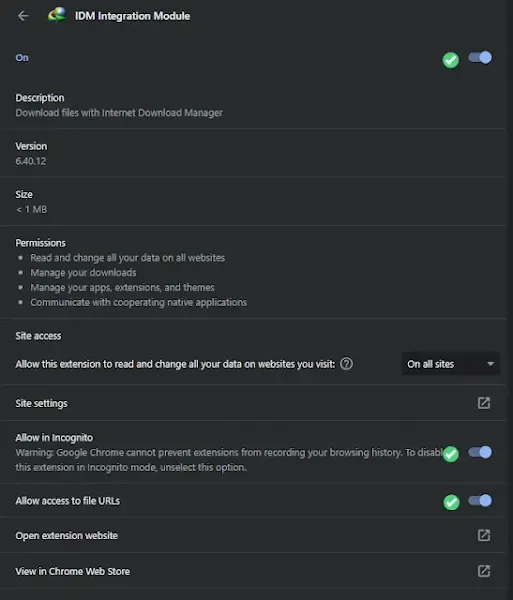
That’s it! IDM is now fully operational in your Chrome Incognito windows.
Pro-Tip:
If you don’t see the IDM download panel on videos right away, try refreshing the page or restarting your browser to ensure the changes take effect.
Mozilla Firefox
For Firefox users, the process is just as simple but uses slightly different terminology.
Step 1: Open Add-ons and Themes
Click the hamburger menu (three horizontal lines) in the top-right corner and select Add-ons and Themes.
Step 2: Manage the IDM Extension
In the Add-ons Manager tab, find IDM Integration Module in the list and click on it to open its settings.
Step 3: Allow in Private Windows
Scroll down to the option that says Run in Private Windows and make sure the radio button next to Allow is selected.
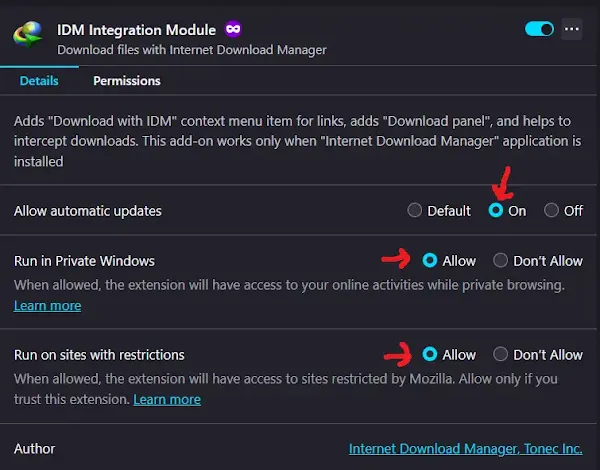
Your changes are saved automatically. IDM will now work seamlessly in Firefox Private Windows.
Pro-Tip:
Firefox’s Container Tabs feature can sometimes interfere with extensions. If you’re having trouble, try using IDM in a standard Private Window without containers.
Opera & Opera GX
Whether you’re using the standard Opera browser or the gamer-focused Opera GX, the steps are identical.
Step 1: Go to Extensions
Click the “O” menu icon in the top-left corner and select Extensions, then click Extensions again (or simply press Ctrl+Shift+E).
Step 2: Find IDM and View Details
Locate the IDM Integration Module in your list of extensions and click on it to open its settings.
Step 3: Allow in Private Mode
Scroll down until you see the option Allow in private mode and toggle the switch to the ON position.
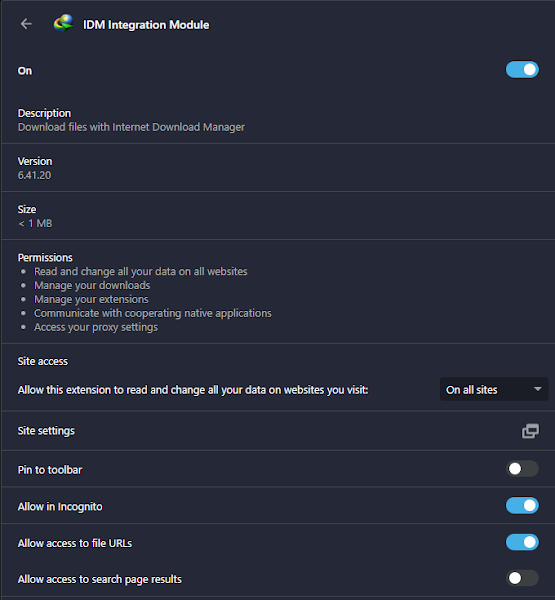
You’re all set! IDM is now ready for action in Opera’s private windows.
Pro-Tip:
Opera’s built-in VPN and ad-blocker can sometimes conflict with download managers. If IDM fails to grab a link, try temporarily disabling them for that site to see if it resolves the issue.
Brave Browser
Brave is built on Chromium, so the process will feel very familiar to Chrome users.
Step 1: Open the Extensions Menu
Click the menu icon (three horizontal lines) in the top-right corner and choose Extensions from the list.
Step 2: Go to IDM Details
Find the IDM Integration Module and click on the Details button.
Step 3: Allow in Private
Find the switch labeled Allow in private and turn it on.
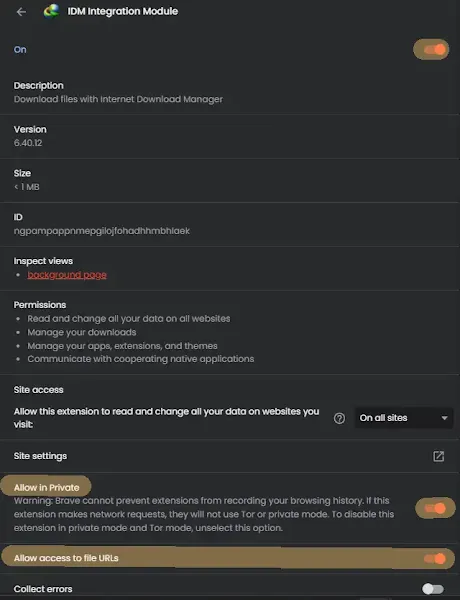
IDM is now configured to work inside Brave’s Private Windows.
Pro-Tip:
Brave’s Shields are powerful. If a download button isn’t appearing, look at the Brave Shields icon in the address bar. You may need to lower the shields for that specific site to allow the necessary scripts to run.
Microsoft Edge
Microsoft’s modern Edge browser is also based on Chromium, making this process straightforward.
Step 1: Manage Extensions
Click the menu icon (three horizontal dots) in the top-right corner and select Extensions. Then click Manage extensions.
Step 2: Find the IDM Module
Locate the IDM Integration Module from the list of your installed extensions.
Step 3: Allow in InPrivate
Click the toggle switch for Allow in InPrivate to enable it for private browsing sessions.
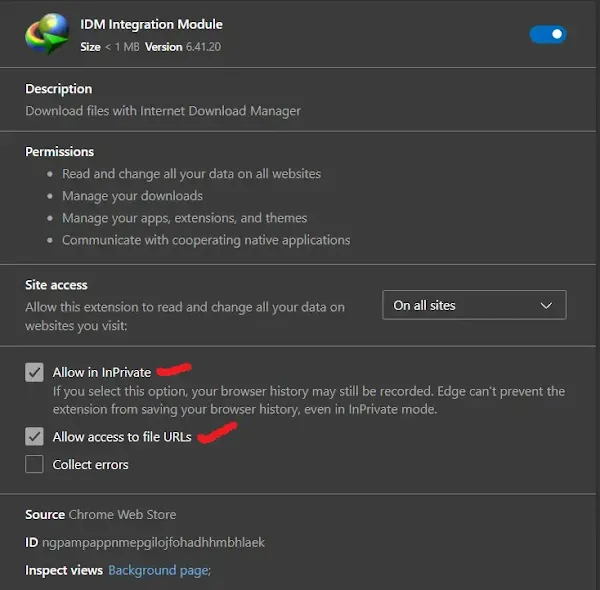
IDM is now ready to handle your downloads in Edge’s InPrivate windows.
Pro-Tip:
If you’ve installed Edge on macOS, the steps are identical. The interface is consistent across operating systems.
Tor Browser
Tor Browser is based on Firefox, so enabling add-ons in its private-by-default mode is very similar.
Step 1: Go to Add-ons
Click the hamburger menu (three horizontal lines) in the top-right corner and select Add-ons and Themes.
Step 2: Find the IDM Extension
Find the IDM Integration Module in the list and click it to manage its settings.
Step 3: Run in Private Windows
Since Tor Browser *only* operates in a private mode, this setting should be enabled by default. However, you can verify it by checking that Run in Private Windows is set to Allow.

Now you can leverage IDM’s speed even when using the privacy-focused Tor Browser.
Pro-Tip:
Using a download manager like IDM with Tor can potentially alter your traffic patterns, which could impact your anonymity. Use this combination with caution and be aware of the security implications.
Frequently Asked Questions (FAQ)
Why is the IDM extension disabled in incognito mode by default?
This is a standard security practice for all browsers. Private or incognito mode is designed to leave no trace of your activity on your device. Since extensions can potentially track and store data, browsers disable them by default to protect your privacy. You have to manually grant permission for each extension you trust.
Will using IDM in incognito mode make my downloads completely anonymous?
No, it will not. This is a critical point to understand. Incognito mode only prevents your browser from saving your history, cookies, and site data on your local device. Your Internet Service Provider (ISP), your employer or school (if on their network), and the websites you visit can still see your IP address and track your activity, including your downloads.
What should I do if the ‘Allow in incognito’ option is greyed out or missing?
This can happen for a few reasons:
- Outdated Browser or Extension: Ensure both your web browser and the IDM Integration Module are updated to the latest versions.
- Conflicting Policy: If you’re on a work or school computer, an administrator may have set a policy that prevents extensions from running in private mode. In this case, you won’t be able to change the setting.
- Corrupted Installation: Try reinstalling the IDM extension. Remove it from your browser, restart the browser, and then add it again from the official source or through the IDM application.
Is it safe to allow extensions like IDM to run in private mode?
For a reputable and well-known extension like the official IDM Integration Module, the risk is generally very low. You are simply allowing it to perform its primary function—intercepting downloads—in a private context. However, you should be very cautious about granting this permission to unknown or untrustworthy extensions, as they could compromise the privacy you’re seeking from incognito mode.
How do I open a private window in my browser?
Here are the common keyboard shortcuts for opening a new private window:
- Google Chrome: Press Ctrl + Shift + N (on Windows/Linux) or Cmd + Shift + N (on Mac).
- Mozilla Firefox: Press Ctrl + Shift + P (on Windows/Linux) or Cmd + Shift + P (on Mac).
- Microsoft Edge: Press Ctrl + Shift + N (on Windows/Linux) or Cmd + Shift + N (on Mac).
- Opera / Opera GX: Press Ctrl + Shift + N (on Windows/Linux) or Cmd + Shift + N (on Mac).
- Brave: Press Ctrl + Shift + N (on Windows/Linux) or Cmd + Shift + N (on Mac).
You can also typically find the option in the main browser menu, labeled as “New Incognito Window,” “New Private Window,” or “New InPrivate Window.”
